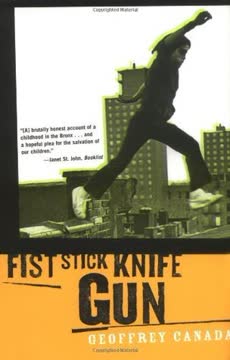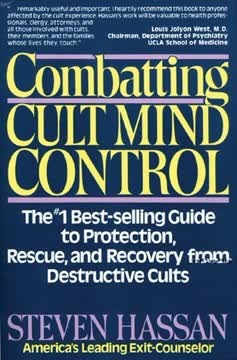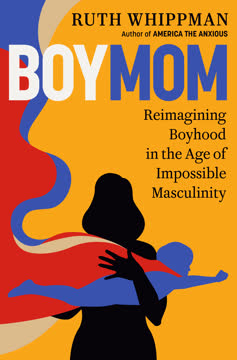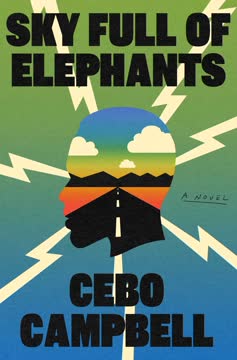Key Takeaways
1. Violence is a Learned Behavior, Not an Innate Trait
I remember clearly the time in my life when I knew nothing of violence and how hard I worked later to learn to become capable of it.
Early Innocence Lost. The author emphasizes that violence is not inherent but acquired through environmental conditioning. He recalls a time when he was unaware of violence, highlighting the deliberate process of learning to navigate and participate in it for survival.
The Jacket Incident. A pivotal moment occurred when his brother had his jacket stolen. His mother forced the older brother to retrieve it, instilling the idea that passivity is unacceptable. This event marked the end of innocence and the beginning of understanding the "laws of the jungle."
Counseling Violent Children. The author's experience counseling children who acted violently because their parents instructed them to do so further reinforces the learned nature of violence. Parents, feeling helpless in urban war zones, often teach their children to be more violent as a means of self-protection.
2. The Streets Have a Code: Respect, Heart, and Retaliation
Don’t cry. Don’t act afraid. Don’t tell your mother. Take it like a man. Don’t let no one take your manhood.
Union Avenue's Rules. Growing up in the South Bronx, the author learned a strict code of conduct centered on respect, fearlessness, and retaliation. These rules, enforced by older boys, dictated how to respond to threats and maintain status within the community.
"Having Heart" is Essential. "Having heart" meant being unafraid to fight, even if defeat was likely. Refusal to fight resulted in ostracization and victimization, making it better to fight and lose than to be labeled a coward. The story of Butchie, who was brutally "stretched" for being a coward, illustrates this point.
The Pecking Order. The streets had a clear hierarchy, with older teens at the top and younger children at the bottom. Status was determined by fighting ability, and new arrivals had to prove themselves through combat to establish their place in the order. This system, while violent, also provided a way for boys to back down without losing face if they were outmatched.
3. Guns Change Everything: Escalation and Impotence of Adult Authority
The nature of the violent act has changed from the fist, stick, and knife to the gun.
Handguns' Lethal Impact. The introduction of handguns into inner-city communities drastically altered the landscape of violence. What were once fistfights or knife altercations became potentially deadly encounters, escalating conflicts and reducing the chances of survival.
Erosion of Natural Checks. The author notes that traditional checks on violence, such as fair fights and community intervention, have been undermined by the prevalence of guns. The fear of being shot has led to a "shoot first" mentality, further fueling the cycle of violence.
Adults' Powerlessness. Schools, despite implementing measures like metal detectors, often fail to provide a sense of safety. Children understand that adults are powerless to protect them, leading them to rely on their own means of self-defense, often involving weapons.
4. The Drug Trade Exploits Children, Fueling Violence
They began to use children. And many children were eager and willing to be used in such a fashion.
Rockefeller Drug Laws' Unintended Consequences. The author argues that strict drug laws, like the Rockefeller laws in New York, inadvertently created a market for child drug dealers. Adults, facing severe penalties, began using children to carry and sell drugs, exploiting their vulnerability and desperation.
Crack Cocaine's Devastating Impact. The arrival of crack cocaine in the 1980s led to an explosion of drug-related violence. The drug's low cost and highly addictive nature created a massive demand, drawing more children into the trade and arming them with guns for protection.
The Cycle of Violence and Profit. The author explains that young dealers, flush with cash, often spent their earnings on designer clothes and jewelry, making them targets for robbery. To protect themselves, they acquired guns, further escalating the violence and creating a deadly cycle.
5. Community Investment and Caring Adults are the Antidote
Adults standing side-by-side with children in the war zones of America is the only way to turn this thing around.
The Beacon School Model. The author advocates for comprehensive community-based programs, like the Beacon Schools, that provide a range of services and activities for children and families. These programs aim to create safe spaces, foster positive relationships, and offer alternatives to violence.
Community Involvement is Key. The author emphasizes the importance of involving community residents in the planning and implementation of these programs. By empowering local voices and addressing their specific needs, these initiatives can build trust and create lasting change.
The Harlem Children's Zone. The author highlights the success of the Harlem Children's Zone, a comprehensive initiative that provides a continuum of services, from early childhood education to college preparation, to children and families in a targeted geographic area. This model demonstrates the power of sustained, holistic investment in a community.
6. Peacemakers: Training Youth in Conflict Resolution
We figured our children stand more of a chance of being killed on 144th Street than do members of U.N. peacekeeping forces in war-ravaged countries—and that we ought to be giving them some real skills in making peace.
Empowering Youth as Mediators. The author describes the Peacemakers program, which trains young people in conflict resolution and negotiation skills. This program equips them with the tools to de-escalate conflicts and promote peaceful solutions in their communities.
Learning from the Experts. The program draws inspiration from U.N. peacekeeping forces, teaching children the same strategies used to make peace in hostile territories. This approach recognizes the unique challenges faced by young people in violent environments and provides them with practical skills for survival.
Safety Plans and Community Knowledge. The author emphasizes the importance of involving children in designing safety plans for their schools and neighborhoods. Children possess valuable knowledge about the dynamics of violence and can identify potential hotspots and effective prevention strategies.
7. The Gun Industry Targets Youth for Profit
The firearms industry decided to: Expand the market beyond white males with the new target markets being women and youth.
Marketing to Vulnerable Populations. The author reveals the disturbing truth that the firearms industry has deliberately targeted youth and women in its marketing efforts. This strategy involves giving weapons enticing names, promoting the idea that bigger is better, and making guns more affordable.
The Allure of Guns. The author notes that young people are often fascinated by guns, knowing the names, models, and capabilities of various weapons. This fascination, fueled by targeted marketing, normalizes gun ownership and increases the likelihood of violence.
The Easy Availability of Guns. The author highlights the ease with which young people can acquire guns on the black market, even in cities with strict gun control laws. This accessibility, combined with the allure of guns, creates a dangerous environment where violence can easily escalate.
8. The Cycle of Violence: From Victim to Perpetrator
These days these punks get a gun and they think they can just shoot anybody.
The Fear of Victimization. The author explains that many young people carry guns for protection, fearing that they will become victims of violence. This fear, however, often leads to a "shoot first" mentality, perpetuating the cycle of violence.
The Loss of Limits. The author notes that guns eliminate the natural checks on violence that existed in the past. Young people with guns often feel empowered to confront others and resolve conflicts through force, without considering the consequences.
The "Rep" and the Gun. The author explains that in the past, "rep" was earned through fighting ability and street smarts. Today, however, "rep" is often determined by the lethality of the gun one carries, leading to a culture of violence and intimidation.
9. The Importance of Mentorship and Positive Role Models
If I have accomplished anything with my life, Mike is directly responsible.
Mike's Influence. The author credits Mike, an older boy in his neighborhood, with teaching him the codes of conduct and protecting him from violence. Mike served as a mentor and role model, guiding the author through the challenges of growing up in the South Bronx.
The Need for Positive Alternatives. The author emphasizes the importance of providing young people with positive role models and alternatives to the allure of gangs and drug dealing. These role models can offer guidance, support, and a sense of hope for the future.
The Power of Caring Adults. The author highlights the transformative impact of caring adults who are willing to stand alongside young people in their communities. These adults can provide a sense of safety, security, and belonging, helping children resist the pressures of violence.
10. Beyond Quick Fixes: Comprehensive Community Solutions
The only way we are going to make a difference is by placing well-trained and caring adults in the middle of what can only be called a free-fire zone in our poorest communities.
Rejecting Simplistic Solutions. The author criticizes the tendency to rely on simplistic solutions, like hiring more police and building more prisons, to address the complex problem of violence. These approaches, he argues, fail to address the root causes of violence and often exacerbate the problem.
Investing in Prevention. The author advocates for investing in comprehensive prevention strategies, such as early childhood education, after-school programs, and community development initiatives. These programs aim to create a supportive environment for children and families, reducing the likelihood of violence.
The Long-Term Commitment. The author emphasizes that addressing violence requires a long-term commitment to rebuilding communities and empowering residents. This involves creating opportunities for education, employment, and economic development, as well as fostering a sense of hope and belonging.
Last updated:
FAQ
1. What is "Fist Stick Knife Gun" by Geoffrey Canada about?
- Personal history of violence: The book is a memoir in which Geoffrey Canada recounts his experiences growing up in the South Bronx, detailing how violence shaped his childhood and adolescence.
- Evolution of street violence: Canada explores the progression of violence from fistfights to the prevalence of guns, showing how the rules and codes of conduct changed over time.
- Social commentary: The book is also a critique of American society’s relationship with violence, poverty, and the failure of institutions to protect children in inner-city communities.
- Call for solutions: Canada uses his story to advocate for community-based interventions, education reform, and comprehensive strategies to address youth violence.
2. Why should I read "Fist Stick Knife Gun" by Geoffrey Canada?
- Firsthand perspective: The book offers an authentic, insider’s view of what it’s like to grow up in a violent, impoverished urban environment.
- Understanding root causes: It provides valuable insights into the social, economic, and psychological factors that perpetuate violence among youth.
- Relevance to current issues: The themes of gun violence, systemic neglect, and community solutions remain highly relevant in today’s society.
- Inspiration for change: Canada’s journey from victim to advocate demonstrates the power of resilience and the importance of community action.
3. What are the key takeaways from "Fist Stick Knife Gun"?
- Violence is learned: Canada argues that violence is not innate but taught and reinforced by environment, peers, and sometimes even parents.
- Codes of conduct matter: The unwritten rules governing street life can both protect and endanger children, and these codes evolve with the introduction of more lethal weapons.
- Institutional failure: Schools, police, and social services often fail to protect vulnerable children, leaving them to fend for themselves.
- Community-based solutions: Comprehensive, locally-driven programs like the Harlem Children’s Zone are essential for breaking cycles of violence and poverty.
4. How does Geoffrey Canada describe the evolution of violence in his community?
- From fists to guns: Canada details how conflicts escalated from fistfights to the use of sticks, knives, and eventually guns, making violence deadlier and more unpredictable.
- Loss of checks and balances: Earlier, street fights had rules and limits, but the proliferation of guns removed natural restraints and increased the lethality of confrontations.
- Impact of drugs: The rise of the drug trade, especially crack cocaine, brought more money, guns, and violence into the hands of younger children.
- Changing street codes: The old codes of conduct eroded, replaced by a culture where preemptive violence and gun use became normalized.
5. What are the "codes of conduct" discussed in "Fist Stick Knife Gun" and why are they important?
- Unwritten street rules: These are informal rules that dictate how children and teens interact, resolve disputes, and maintain status or safety on the block.
- Enforcement by peers: Older boys enforce these codes, teaching younger ones when to fight, when to back down, and how to avoid being labeled a coward.
- Survival mechanism: Following the codes is often a matter of survival, as breaking them can lead to repeated victimization or social isolation.
- Erosion with guns: The introduction of guns undermined these codes, making violence more random and less governed by any sense of fairness or restraint.
6. How does Geoffrey Canada address the role of parents and adults in "Fist Stick Knife Gun"?
- Parental dilemmas: Many parents, especially single mothers, feel forced to teach their children to fight back to avoid victimization, even if it means encouraging violence.
- Institutional impotence: Adults in schools and law enforcement are often unable or unwilling to protect children, leading parents to take matters into their own hands.
- Mentorship and protection: Positive adult figures, like Canada’s mentor Mike, play a crucial role in teaching survival skills and providing emotional support.
- Need for community involvement: Canada advocates for adults to be present and active in children’s lives, both as protectors and as role models for nonviolent conflict resolution.
7. What does "Fist Stick Knife Gun" say about the impact of guns on youth and communities?
- Escalation of violence: The easy availability of guns dramatically increases the lethality of conflicts and removes previous limits on violence.
- Psychological effects: Carrying a gun gives young people a false sense of power and invincibility, often leading them to take greater risks.
- Breakdown of order: Guns disrupt the social order, making it impossible for traditional codes of conduct to function and increasing fear and mistrust.
- Targeted marketing: Canada exposes how gun manufacturers deliberately marketed firearms to youth and minorities to expand their market, worsening the crisis.
8. How does Geoffrey Canada critique traditional approaches to crime and violence prevention?
- Ineffectiveness of policing: Canada argues that simply hiring more police or building more prisons does not address the root causes of violence and often breeds mistrust in poor communities.
- Problems with punitive measures: Mandatory sentencing and harsh drug laws have unintended consequences, such as drawing more children into the drug trade and criminal justice system.
- Need for prevention: He advocates for investment in prevention, education, and comprehensive community programs rather than relying solely on punishment.
- Community trust: Effective solutions require building trust between residents and institutions, and involving community members in designing and implementing interventions.
9. What is the Harlem Children’s Zone and how does it relate to the solutions proposed in "Fist Stick Knife Gun"?
- Comprehensive support model: The Harlem Children’s Zone (HCZ) is a network of programs providing education, social services, and community-building activities for children and families in Harlem.
- Beacon Schools: HCZ’s Beacon Schools serve as community hubs, offering extended hours, adult education, recreation, and support services to address multiple needs.
- Focus on prevention: The HCZ model emphasizes early intervention, sustained support, and the involvement of parents and community members.
- Replicable approach: Canada presents HCZ as a model that can be adapted to other communities facing similar challenges with violence and poverty.
10. What are the "Peacemakers" and what role do they play in Geoffrey Canada’s vision?
- Youth conflict mediators: The Peacemakers program trains children and teens in conflict resolution, negotiation, and leadership skills to help prevent violence among their peers.
- Empowering children: By involving youth directly in violence prevention, the program recognizes them as experts in their own environment and gives them agency.
- Community impact: Peacemakers organize marches, mediate disputes, and create safety plans, fostering a culture of peace and responsibility.
- Model for change: The program exemplifies Canada’s belief that children must be part of the solution and that peace can be taught and practiced, even in the most challenging environments.
11. What are some of the most powerful quotes from "Fist Stick Knife Gun" and what do they mean?
- "Violence is a learned response; I know this from my earliest education on the street." – Canada emphasizes that violence is not innate but taught by environment and necessity.
- "For the handgun generation there is no post-traumatic stress syndrome because there is no 'post.'" – He highlights the ongoing, unending trauma experienced by children in violent communities.
- "If we are to save our children then we must become people they will look up to. Children need heroes now more than ever because the poor children of this nation live with monsters every day." – Canada calls for adults to step up as visible, positive role models and protectors.
- "We have realized that you cannot save children without saving families, and you cannot save families without rebuilding communities." – He stresses the interconnectedness of individual, family, and community well-being.
12. What practical advice or methods does Geoffrey Canada offer for addressing youth violence in "Fist Stick Knife Gun"?
- Invest in prevention: Focus resources on early intervention, education, and comprehensive support rather than relying solely on punitive measures.
- Community engagement: Involve residents, especially youth, in designing and implementing programs that address their real needs and experiences.
- Build trust and relationships: Foster trust between institutions (schools, police, social services) and the community to create effective, sustainable change.
- Empower youth: Train young people as leaders and peacemakers, giving them the skills and confidence to resolve conflicts nonviolently and to support one another.
Review Summary
Fist Stick Knife Gun is a powerful memoir by Geoffrey Canada about growing up in the South Bronx amid violence. Adapted into a graphic novel, it vividly portrays the escalation of weapons from fists to guns. Readers praise Canada's honest storytelling, compelling narrative, and important message about inner-city violence. The book offers insight into street life, survival, and the author's journey to become an advocate for at-risk youth. While some found the tone overly confident, most consider it an eye-opening, essential read that resonates with current issues of urban violence.
Similar Books
Download PDF
Download EPUB
.epub digital book format is ideal for reading ebooks on phones, tablets, and e-readers.







